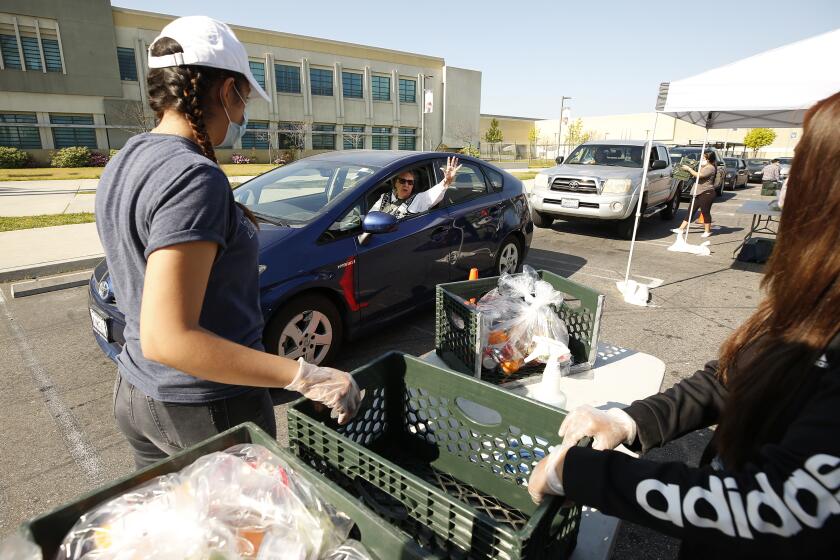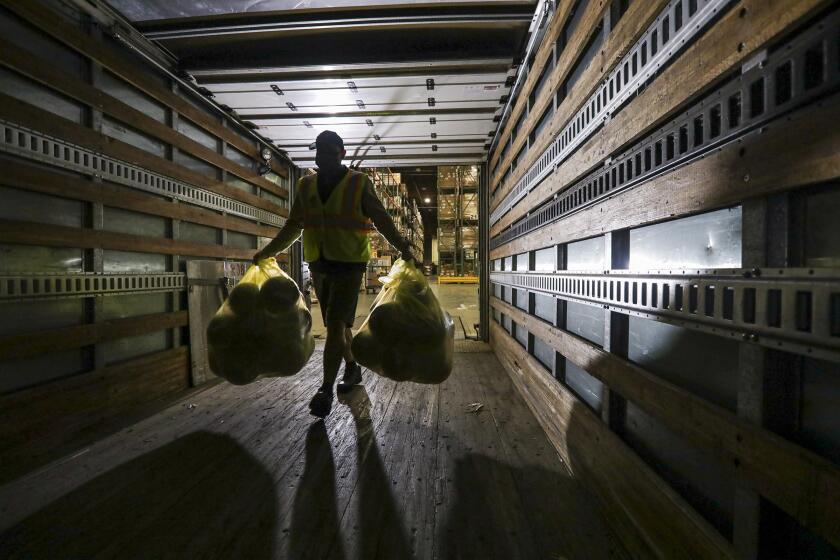L.A. school lunches go healthy with mango smoothies, ramen, berries. Will students bite?
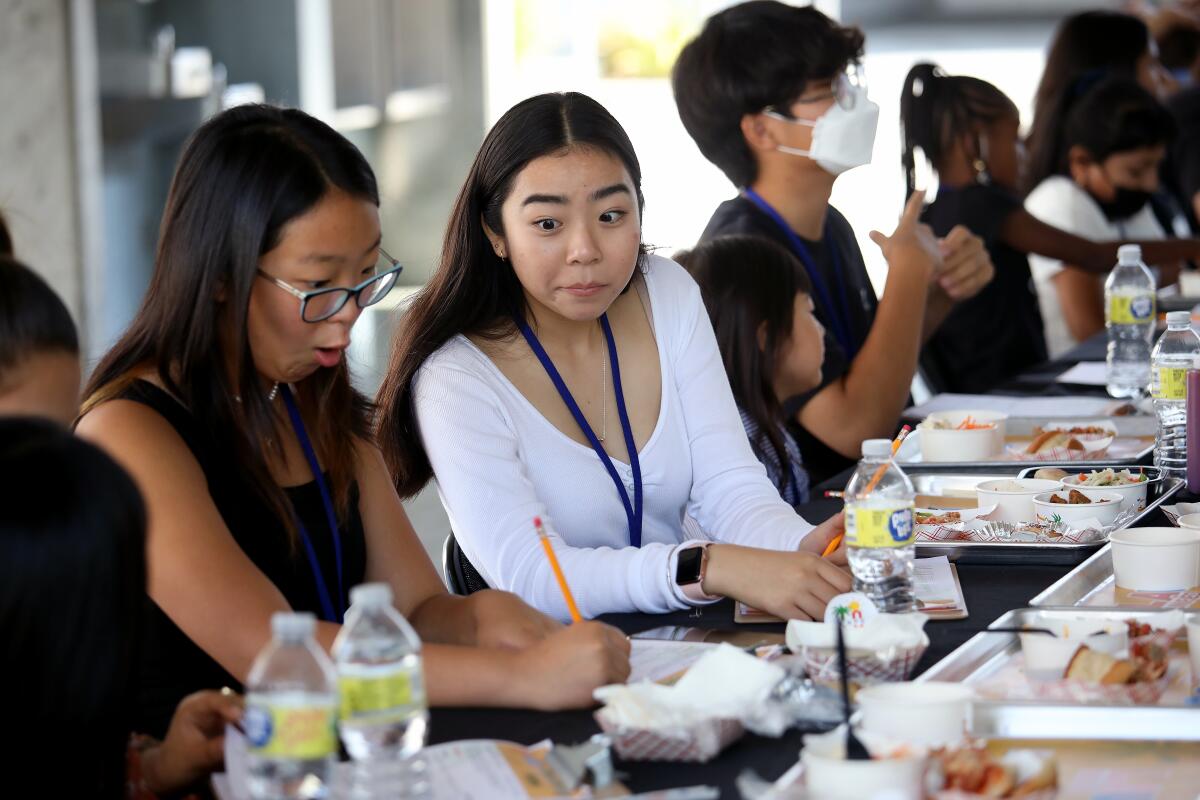
- Share via
Los Angeles school chefs — largely responsible for providing the main source of daily nutrition for tens of thousands of children — served up new back-to-school options Friday, the latest attempt to provide healthful yet appealing food to youthful taste buds. But in a world of Flamin’ Hot Cheetos, will students eat their school meals?
Enter turkey, ham and cheese croissants for breakfast. “Nashville” hot chicken tenders and honey biscuits, mango smoothies and meatball sub sandwiches for lunch.
“It is good,” wrote diminutive third-grader Antonio Plascencia on his grading form, which he intended as high praise. He polished off his croissant sandwich before even moving to the next item on his tray.
Feeding L.A.’s children has long been an imperative in the nation’s second-largest school district. About 80% of students are from low-income families and many grapple with food insecurity. Parents’ long work schedules can be an additional challenge for preparing meals, let alone healthful ones. Every school day, the $180-million-a-year L.A. Unified program serves more than 300,000 breakfasts, about 285,000 lunches and about 70,000 early dinners.
During 13 months of pandemic-forced school closures, L.A. Unified filled the hunger void by offering grab-and-go food for any takers, surpassing the generosity and costs borne by many other school systems during the crisis.
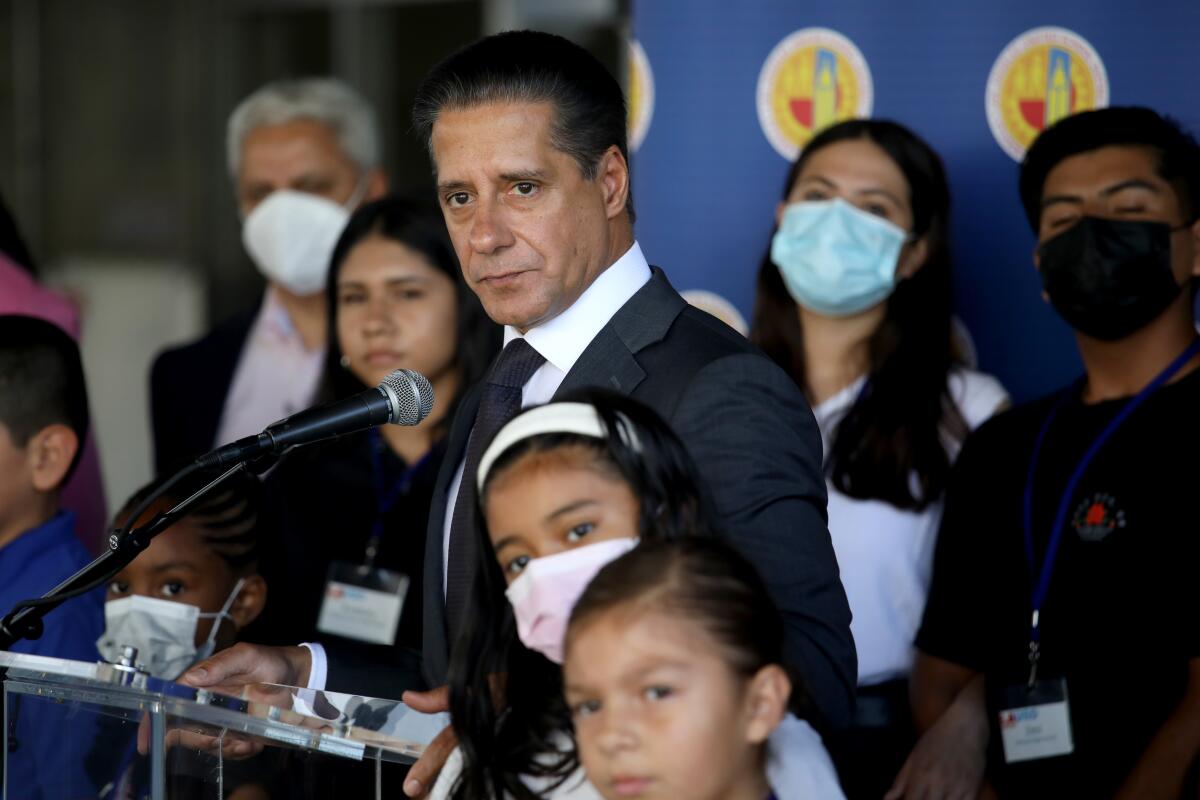
“A disproportionate number of our kids live in poverty,” Supt. Alberto Carvalho said Friday. “We offer breakfast and lunch for free — no questions asked — for every single kid in our school system. We’re addressing the food insecurity in our community by providing nutritious healthy food options. They’re also appealing. Why is this important? Hungry kids don’t learn well.”
He added his own reviews: “The new cinnamon rolls — very tasty. The kung pao chicken, honey glazed with brown rice and broccoli — delicious.”
The items were prepared in the kitchen at the downtown Cortines School of Visual and Performing Arts for about 30 generally satisfied student tasters. But it is a long way from this setting to the mass-producing central kitchens, from which items are trucked to campuses.
The central-kitchen system has been an impediment to taste, despite quality ingredients and menus that meet or surpass federal guidelines. That’s because many hot food items are, in effect, akin to reheated leftovers by the time they are served to students.
Coronavirus: While food banks struggle, L.A.’s schools are feeding the hungry
In the overcrowded L.A. Unified of the 1990s, efficiency was the priority in meal preparation, with central kitchens taking over for food prepared at school cafeterias — and prepackaged food stations installed to keep long lines moving. Many of the more than 100 new campuses lacked functional kitchens. And remodels of existing schools often removed cooking equipment.
Student tester Sebastine Chun, an 11th-grader at Chatsworth High School, recounted the unpleasant experience of receiving a moldy hamburger.
About 40% of menu items can now be prepared at schools. Food managers have reformulated the preparation, adding in more salads, for example, that can be assembled on-site while rethinking other recipes and obtaining new equipment. The goal is to achieve “speed scratch” cooking, under which things are done quickly but as homemade as possible, said Manish Singh, the district’s director of food services.
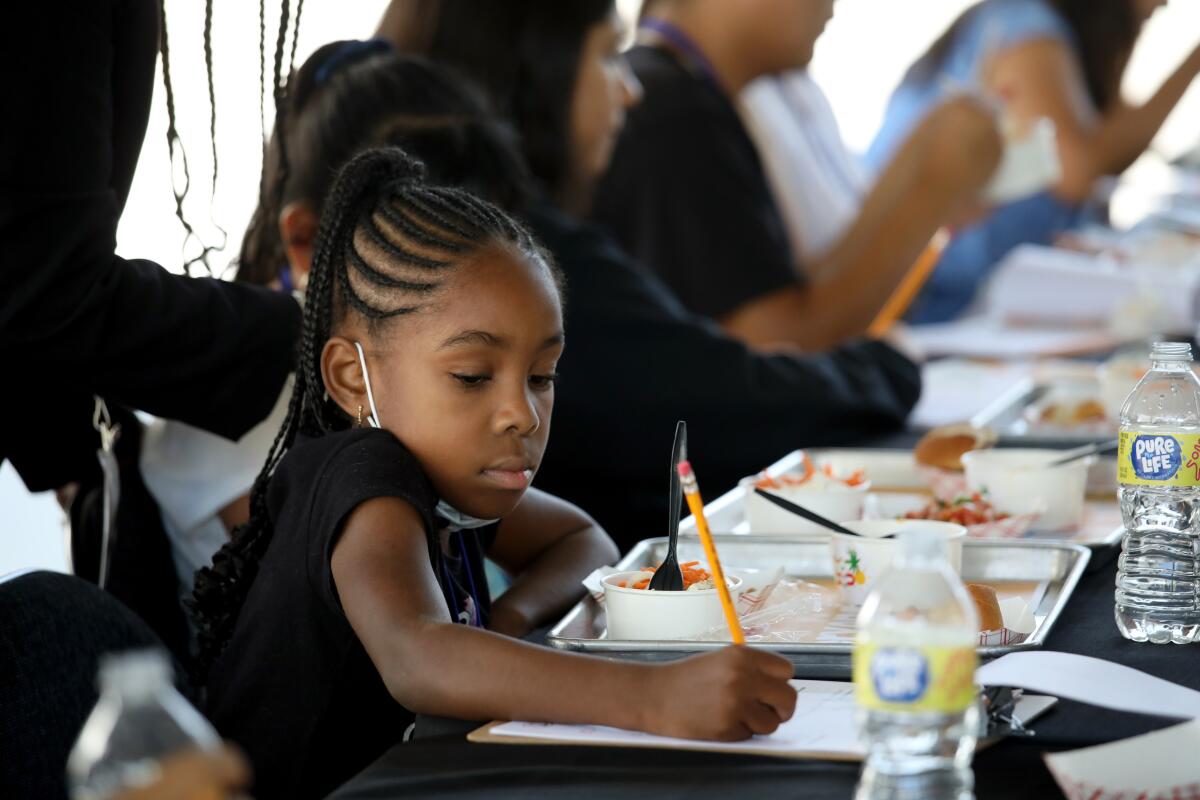
Singh proudly pointed out to one student that all the sweetness in the strawberry smoothie bowl comes from the yogurt and fruit. No sugar added. Also no nitrates, no sulfites, no artificial colors, no artificial flavors.
Sebastine was impressed by the ramen bowl: “The flavors are something I would expect to see at a restaurant, which is really surprising.”
But second-grader Faith Posada found her ramen too bland: “It has no flavor.” The croissant and the cinnamon bun, however, she rated “10 out of 10.”
Of course, generations of students everywhere have complained about school lunches. But for all the complaints, L.A. Unified has been a leader in some innovations.
L.A. Unified was among the first to ban soda and prepackaged junk food. The district then transitioned into healthier items, moving in 2011 from chicken nuggets, corn dogs, nachos and other foods high in fat, sugar and sodium to black bean burgers, tostadas, quinoa salad, vegetarian curry and fresh pears. But fewer students ate those lunches, often substituting Flamin’ Hot Cheetos and soda from their backpacks.
More healthful foods might stand a better chance a decade later. Before the pandemic, for example, a group of vegan students and their parents regularly descended on school board meetings demanding the kind of foods they favored.
With school closed for the coronavirus, LAUSD, the nation’s second-largest district, has given out about 10 million meals since March 18.
The testers on Friday included Karen Ramirez, 16, a vegetarian who wished there’d been more such options available. But the mango smoothie was promising: “I like the idea of it. But I think it could have tasted less like yogurt with a little bit more emphasis on the mango.”
L.A. Unified has tried to innovate in various ways, with an initiative to purchase locally sourced ingredients and to use its buying power to influence farming practices. About seven years ago, when the school board set new standards for how suppliers should treat their poultry, their workers and the environment, contract talks with the nation’s largest two suppliers fell apart, leading to a year of virtually no chicken on school lunch menus.
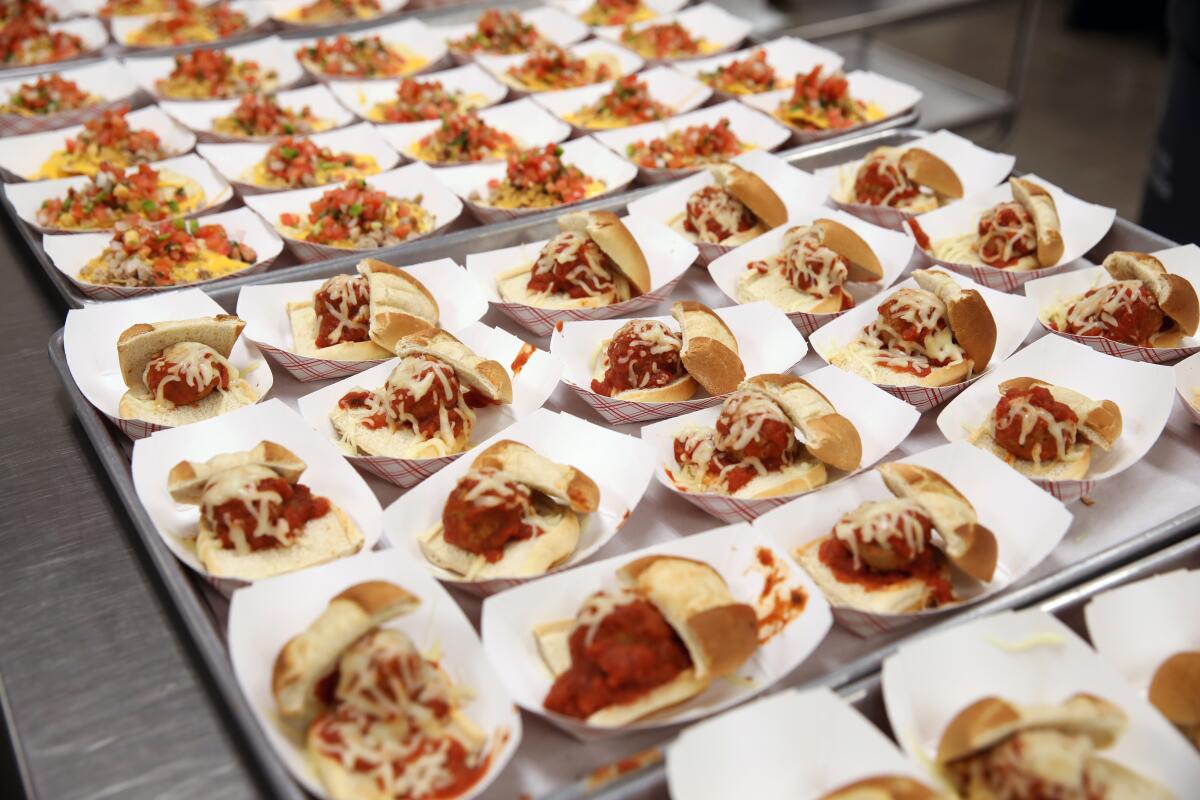
The district has also tried to curb food waste, but it has far to go on that front.
Along the way there’s been angst — chocolate milk was banned and then returned after students weren’t drinking regular milk. Breaded chicken was removed, then brought back.
There’s also been labor intrigue — the school board approved health benefits for part-time cafeteria workers even though it threw the food program into a deficit at the time. On the upside, that policy also provided vital health coverage for low-wage workers and their families.
And befitting the school district that includes Hollywood, there’s even been drama — the district refused to permit celebrity chief Jamie Oliver to film a show on its campuses — and true crime, when a top district food official and chef was convicted of forgery on a district vendor application.
Jailyn Johnson, a senior who attends King-Drew Medical Magnet, hasn’t been too keen on school food. She remembers getting sick after eating a meal in elementary school, and in middle school she recalled hasty warnings over the intercom not to drink the milk or yogurt after someone noticed it had expired.
In high school, if she forgot her lunch from home, she’d often go hungry rather than eat the campus food. She said it affected her energy level and ability to concentrate. And she’s not the only one: “Sometimes it’s gotten so bad to where teachers will have to bring snacks. I had a teacher who would have a PB and J [peanut butter and jelly] station for students.”
But, on Friday, she was encouraged: “I really am enjoying some of the choices. I’ve really liked the diversity.”
More to Read
Sign up for Essential California
The most important California stories and recommendations in your inbox every morning.
You may occasionally receive promotional content from the Los Angeles Times.
